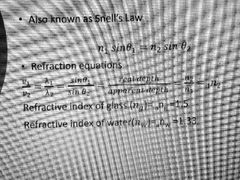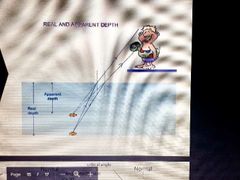![]()
![]()
![]()
Use LEFT and RIGHT arrow keys to navigate between flashcards;
Use UP and DOWN arrow keys to flip the card;
H to show hint;
A reads text to speech;
8 Cards in this Set
- Front
- Back
|
Refraction |
Refraction is the bending of light or the change in the direction of light as it passes from one medium to another. This change in direction occurs as a result of the light ray speeding up or slowing down. Media of differing densities cause this change in velocity. |
|
|
Light Through a Less Dense Medium to a More Dense Medium |
The refractive index (n(with a linger take) is a term used to describe the degree of bending. For example: n water is greater than n air. normal. Therefore, the refracted ray bends towards the normal. This indicates that the angle of refraction is less than the angle of incidence. This indicates that the angle of refraction is less than the angle of incidence. |
|
|
Light through a more dense medium to a less dense medium |
Example: Here the light passes from water to air. The light ray in this case passes from a more dense medium to a less dense medium and bends away from the normal. This indicates that the angle of refraction is greater than the angle of incidence. |
|
|
Laws of Refraction |
-> the incident ray, the refracted rey and the normal all lie in the same plane. -> for two particular media, the ratio of the sine of the angle of incidence to the sine if the angle of refraction is a constant. Snell's Law: n= sin i/sin r |
|
|
Second Law of Refraction |

|
|
|
Real and Apparent Depth |

|
|
|
Critical Angle and Total Internal Reflection |

-> Total internal reflection occurs when light travels from a medium thar is more dense to a medium that is less dense. |
|
|
Total Internal Reflection: Solving for Critical Angle |
-> The critical angle is an angle of incidence for which the refracted ray becomes 90 degrees. -> Beyond this angle, there is no refracted ray and the light is totally internally reflected. i > C -> This occurs when light travels from a more dense medium to a less dense medium. -> Snell's Law becomes: ng(g should be subscript) sinC = na (a should be subscript) sin 90 -> sinC = na/ng =gna= 1/ang (a and g are subscripts of n) |

